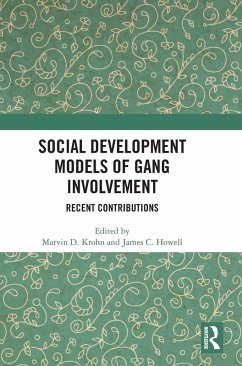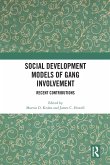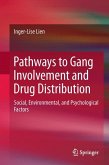Social Development Models of Gang Involvement
Recent Contributions
Herausgeber: Krohn, Marvin D.; Howell, James C.
Social Development Models of Gang Involvement
Recent Contributions
Herausgeber: Krohn, Marvin D.; Howell, James C.
- Gebundenes Buch
- Merkliste
- Auf die Merkliste
- Bewerten Bewerten
- Teilen
- Produkt teilen
- Produkterinnerung
- Produkterinnerung
This book includes original research on issues related to gang membership, its causes, its consequences, and intervention efforts to reduce its effects. This book was originally published as a special issue of the Journal of Crime and Justice.
Andere Kunden interessierten sich auch für
![Social Development Models of Gang Involvement Social Development Models of Gang Involvement]() Social Development Models of Gang Involvement54,99 €
Social Development Models of Gang Involvement54,99 €![Crime and Justice at the Millennium Crime and Justice at the Millennium]() Crime and Justice at the Millennium137,99 €
Crime and Justice at the Millennium137,99 €![Crime and Justice at the Millennium Crime and Justice at the Millennium]() Robert A. Silverman / Terence P. Thornberry / Bernard Cohen / Barry Krisberg (Hgg.)Crime and Justice at the Millennium139,99 €
Robert A. Silverman / Terence P. Thornberry / Bernard Cohen / Barry Krisberg (Hgg.)Crime and Justice at the Millennium139,99 €![Pathways to Gang Involvement and Drug Distribution Pathways to Gang Involvement and Drug Distribution]() Inger-Lise LienPathways to Gang Involvement and Drug Distribution76,99 €
Inger-Lise LienPathways to Gang Involvement and Drug Distribution76,99 €![Pathways to Gang Involvement and Drug Distribution Pathways to Gang Involvement and Drug Distribution]() Inger-Lise LienPathways to Gang Involvement and Drug Distribution76,99 €
Inger-Lise LienPathways to Gang Involvement and Drug Distribution76,99 €![Youth Involvement in Street Gangs in California's Central Valley Youth Involvement in Street Gangs in California's Central Valley]() Huan GaoYouth Involvement in Street Gangs in California's Central Valley169,99 €
Huan GaoYouth Involvement in Street Gangs in California's Central Valley169,99 €![Twenty-one Mental Models That Can Change Policing Twenty-one Mental Models That Can Change Policing]() Renée J. MitchellTwenty-one Mental Models That Can Change Policing148,99 €
Renée J. MitchellTwenty-one Mental Models That Can Change Policing148,99 €-
-
-
This book includes original research on issues related to gang membership, its causes, its consequences, and intervention efforts to reduce its effects. This book was originally published as a special issue of the Journal of Crime and Justice.
Produktdetails
- Produktdetails
- Verlag: Routledge
- Seitenzahl: 188
- Erscheinungstermin: 6. November 2018
- Englisch
- Abmessung: 250mm x 175mm x 15mm
- Gewicht: 514g
- ISBN-13: 9781138493889
- ISBN-10: 1138493880
- Artikelnr.: 52959759
- Herstellerkennzeichnung
- Libri GmbH
- Europaallee 1
- 36244 Bad Hersfeld
- gpsr@libri.de
- Verlag: Routledge
- Seitenzahl: 188
- Erscheinungstermin: 6. November 2018
- Englisch
- Abmessung: 250mm x 175mm x 15mm
- Gewicht: 514g
- ISBN-13: 9781138493889
- ISBN-10: 1138493880
- Artikelnr.: 52959759
- Herstellerkennzeichnung
- Libri GmbH
- Europaallee 1
- 36244 Bad Hersfeld
- gpsr@libri.de
Marvin D. Krohn is a Professor in the Department of Sociology and Criminology & Law at the University of Florida, Gainsville, USA. He is primarily interested in developmental and life-course approaches to the explanation of delinquency, drug use, and crime. He is a Fellow of the American Society of Criminology. James C. Howell is a Senior Research Associate with the National Gang Center, Tallahassee, USA. He is author of The History of Street Gangs in the United States (2015), and a textbook, Gangs in America's Communities (2019). His numerous other works on youth gangs include a developmental theory of gang involvement.
Introduction 1. Exploring intergenerational continuity in gang membership
2. Developmental pathways of youth gang membership: a structural test of
the social development model 3. Differentiating between delinquent groups
and gangs: moving beyond offending consequences 4. School transitions as a
turning point for gang status 5. Leveraging the pushes and pulls of gang
disengagement to improve gang intervention: findings from three multi-site
studies and a review of relevant gang programs 6. Toward a multiracial
feminist framework for understanding females' gang involvement 7. The
practical utility of a life-course gang theory for intervention 8. The
labor market and gang membership in adulthood: is the availability,
quality, and nature of legal work associated with adult gang involvement?
2. Developmental pathways of youth gang membership: a structural test of
the social development model 3. Differentiating between delinquent groups
and gangs: moving beyond offending consequences 4. School transitions as a
turning point for gang status 5. Leveraging the pushes and pulls of gang
disengagement to improve gang intervention: findings from three multi-site
studies and a review of relevant gang programs 6. Toward a multiracial
feminist framework for understanding females' gang involvement 7. The
practical utility of a life-course gang theory for intervention 8. The
labor market and gang membership in adulthood: is the availability,
quality, and nature of legal work associated with adult gang involvement?
Introduction 1. Exploring intergenerational continuity in gang membership
2. Developmental pathways of youth gang membership: a structural test of
the social development model 3. Differentiating between delinquent groups
and gangs: moving beyond offending consequences 4. School transitions as a
turning point for gang status 5. Leveraging the pushes and pulls of gang
disengagement to improve gang intervention: findings from three multi-site
studies and a review of relevant gang programs 6. Toward a multiracial
feminist framework for understanding females' gang involvement 7. The
practical utility of a life-course gang theory for intervention 8. The
labor market and gang membership in adulthood: is the availability,
quality, and nature of legal work associated with adult gang involvement?
2. Developmental pathways of youth gang membership: a structural test of
the social development model 3. Differentiating between delinquent groups
and gangs: moving beyond offending consequences 4. School transitions as a
turning point for gang status 5. Leveraging the pushes and pulls of gang
disengagement to improve gang intervention: findings from three multi-site
studies and a review of relevant gang programs 6. Toward a multiracial
feminist framework for understanding females' gang involvement 7. The
practical utility of a life-course gang theory for intervention 8. The
labor market and gang membership in adulthood: is the availability,
quality, and nature of legal work associated with adult gang involvement?








